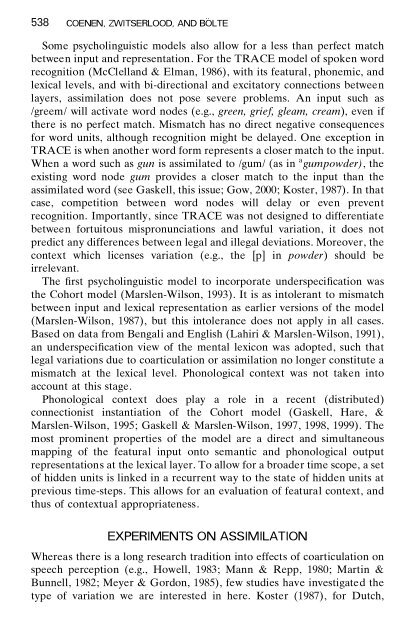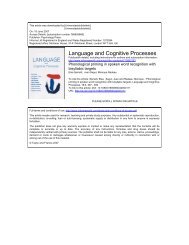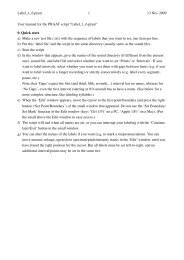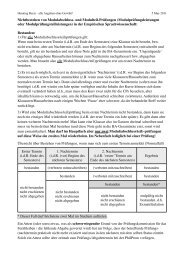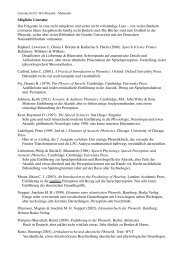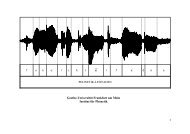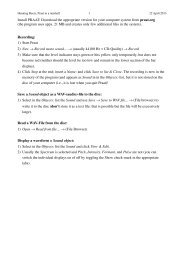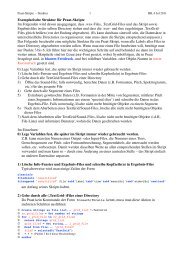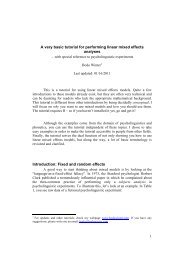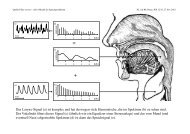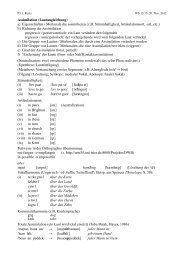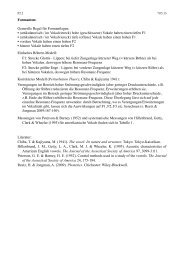Variation and assimilation in German - Institut für Phonetik
Variation and assimilation in German - Institut für Phonetik
Variation and assimilation in German - Institut für Phonetik
Create successful ePaper yourself
Turn your PDF publications into a flip-book with our unique Google optimized e-Paper software.
538 COENEN, ZWITSERLOOD, AND BOÈLTE<br />
Some psychol<strong>in</strong>guistic models also allow for a less than perfect match<br />
between <strong>in</strong>put <strong>and</strong> representation. For the TRACE model of spoken word<br />
recognition (McClell<strong>and</strong> & Elman, 1986), with its featural, phonemic, <strong>and</strong><br />
lexical levels, <strong>and</strong> with bi-directional <strong>and</strong> excitatory connections between<br />
layers, <strong>assimilation</strong> does not pose severe problems. An <strong>in</strong>put such as<br />
/greem/ will activate word nodes (e.g., green, grief, gleam, cream), even if<br />
there is no perfect match. Mismatch has no direct negative consequences<br />
for word units, although recognition might be delayed. One exception <strong>in</strong><br />
TRACE is when another word form represents a closer match to the <strong>in</strong>put.<br />
When a word such as gun is assimilated to /gum/ (as <strong>in</strong> a gumpowder), the<br />
exist<strong>in</strong>g word node gum provides a closer match to the <strong>in</strong>put than the<br />
assimilated word (see Gaskell, this issue; Gow, 2000; Koster, 1987). In that<br />
case, competition between word nodes will delay or even prevent<br />
recognition. Importantly, s<strong>in</strong>ce TRACE was not designed to differentiate<br />
between fortuitous mispronunciations <strong>and</strong> lawful variation, it does not<br />
predict any differences between legal <strong>and</strong> illegal deviations. Moreover, the<br />
context which licenses variation (e.g., the [p] <strong>in</strong> powder) should be<br />
irrelevant.<br />
The rst psychol<strong>in</strong>guistic model to <strong>in</strong>corporate underspecication was<br />
the Cohort model (Marslen-Wilson, 1993). It is as <strong>in</strong>tolerant to mismatch<br />
between <strong>in</strong>put <strong>and</strong> lexical representation as earlier versions of the model<br />
(Marslen-Wilson, 1987), but this <strong>in</strong>tolerance does not apply <strong>in</strong> all cases.<br />
Based on data from Bengali <strong>and</strong> English (Lahiri & Marslen-Wilson, 1991),<br />
an underspecication view of the mental lexicon was adopted, such that<br />
legal variations due to coarticulation or <strong>assimilation</strong> no longer constitute a<br />
mismatch at the lexical level. Phonological context was not taken <strong>in</strong>to<br />
account at this stage.<br />
Phonological context does play a role <strong>in</strong> a recent (distributed)<br />
connectionist <strong>in</strong>stantiation of the Cohort model (Gaskell, Hare, &<br />
Marslen-Wilson, 1995; Gaskell & Marslen-Wilson, 1997, 1998, 1999). The<br />
most prom<strong>in</strong>ent properties of the model are a direct <strong>and</strong> simultaneous<br />
mapp<strong>in</strong>g of the featural <strong>in</strong>put onto semantic <strong>and</strong> phonological output<br />
representations at the lexical layer. To allow for a broader time scope, a set<br />
of hidden units is l<strong>in</strong>ked <strong>in</strong> a recurrent way to the state of hidden units at<br />
previous time-steps. This allows for an evaluation of featural context, <strong>and</strong><br />
thus of contextual appropriateness.<br />
EXPERIMENTS ON ASSIMILATION<br />
Whereas there is a long research tradition <strong>in</strong>to effects of coarticulation on<br />
speech perception (e.g., Howell, 1983; Mann & Repp, 1980; Mart<strong>in</strong> &<br />
Bunnell, 1982; Meyer & Gordon, 1985), few studies have <strong>in</strong>vestigated the<br />
type of variation we are <strong>in</strong>terested <strong>in</strong> here. Koster (1987), for Dutch,


